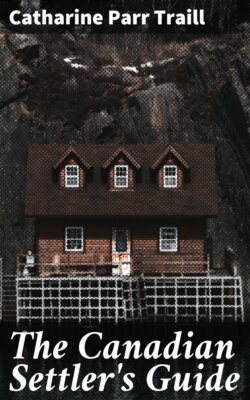Читать книгу The Canadian Settler's Guide - Catharine Parr Traill - Страница 31
На сайте Литреса книга снята с продажи.
GRAFTING WAX
Оглавлениеis made in the following proportions: one part of common beef-tallow; two parts bees' wax; and four parts resin. Melt the whole together, pour into a pail of cold water; rub a little of the grease on your hands, to prevent the wax from sticking, and then as it cools work it well with your hands, first in the water and then on a bit of board, till it is thoroughly kneaded, and will be soft and plastic, without adhering to the fingers or running thin. This wax is spread over the sawn limb and round the graft, and down the wounded bark, so as to exclude the air and moisture; if too soft add a little more wax, or if too hard a little more tallow.
Some use cobbler's wax, some apply pitch, and the common turpentine from the pines; but the wax is neatest, cleanest, and best.—Clay is of little use, as it either dries with the sun, or cracks with the frost. Some use bass bark to bind round the grafts.
The tools used by those persons who make grafting a business, or have large orchards, are a grafting saw, a pruning knife, a wedge-handled knife, a small hammer with an axe at one end, for making clefts in the large boughs, and a bag for the tools, with a strap to pass about the shoulder, and a box for the wax, with string, or a coil of wet bass or cedar bark for binding; but many trees are grafted with only a knife, a saw, and the wax.
Those who know how to graft should early sow the seeds of apples, pears, plums and cherries in a nursery bed, that they may have good vigorous stocks to graft upon.
Not long since I met with an old-fashioned book on orchard-planting, where the following direction was given:
"Sow apple-seeds in a ring, at distances of twenty-five feet from ring to ring, on a space intended for an orchard. When your young trees are up, thin out, to two feet apart, keeping them stirred with the hoe, and free from weeds. At the end of three years graft your young stocks. The following year remove all but one healthy tree from each ring, choosing the very best to become your standard.—The rest of your young grafted trees may be set out in suitable places or sold, but you will find the advantage of never having transplanted your seedling, by the superior growth, and vigour, of your graft over the young stocks that have been checked by transplantation from the native soil."
As a manure for orchard-trees, wood soot, wood ashes, and a small quantity of lime is strongly recommended, especially in wet soil. A dead level, unless drained, is not so favourable for apple trees, as the side of a hill facing south or west. Soap-suds are recommended to wash or scrub the bark of apple and pear trees, to prevent scaly bark, and remove moss. In the Fall, a careful person should examine all the trees, and remove the nests of the caterpillars, which will be found adhering to the young twigs, like a gummy swelling of the bark. These are easily taken off like a brittle, varnished crust. Early in Spring search the trees again; if any escape they will show themselves in the leafing time, and unless the webs which they spin for a shelter, are removed in time, these caterpillars will injure the crop and tree, by devouring the foliage and blossoms.
Having given you some directions for the management of your orchard-trees, I will now furnish you with a list of the most highly approved sorts to select for planting, as the names differ much from those you have been accustomed to see in the English orchards.—America is famous for the excellence of her apples, and those that are the natives of the climate, are always most hardy, prolific, and best adapted for orchard planting in Canadian soil.
